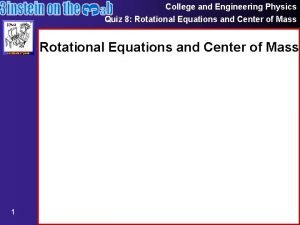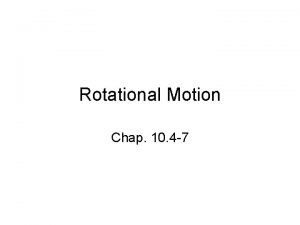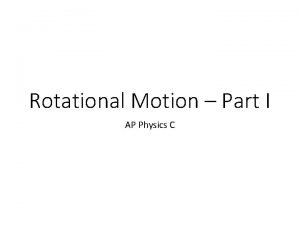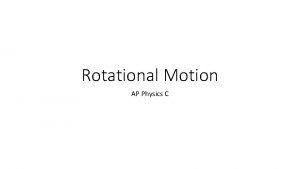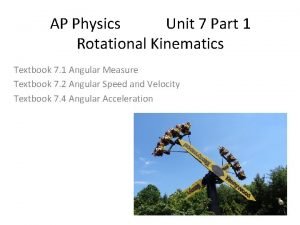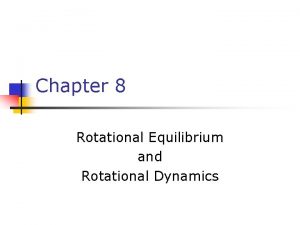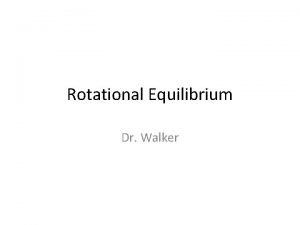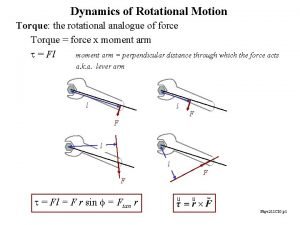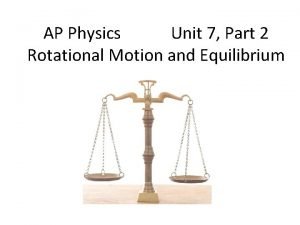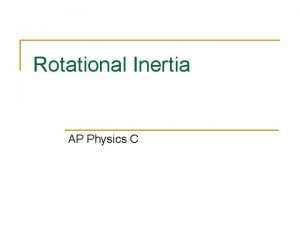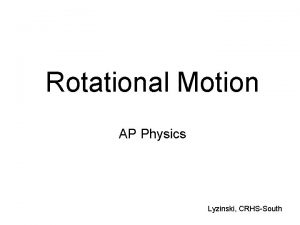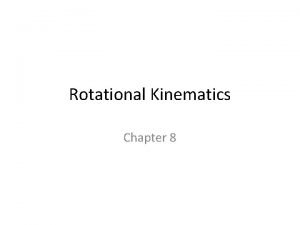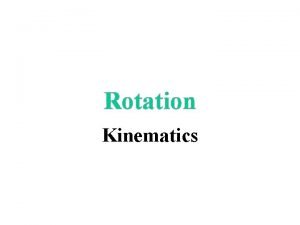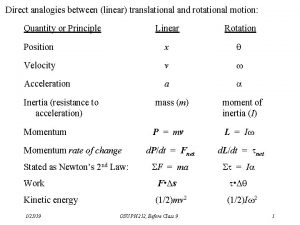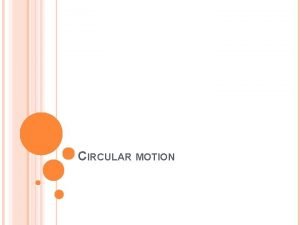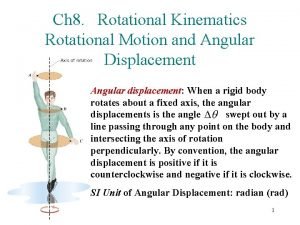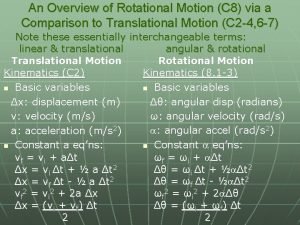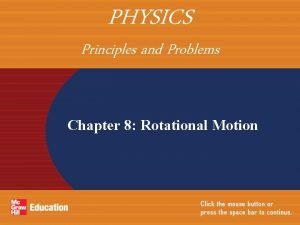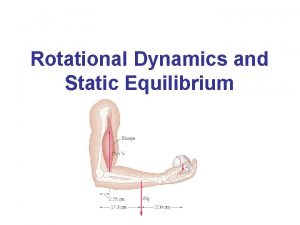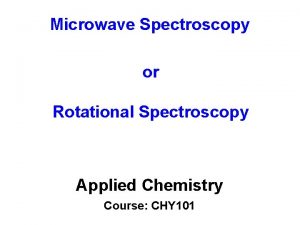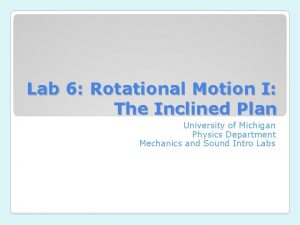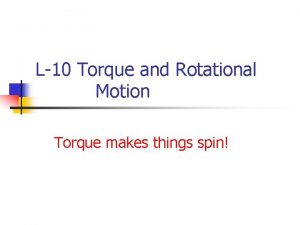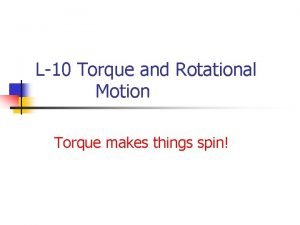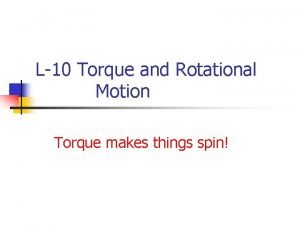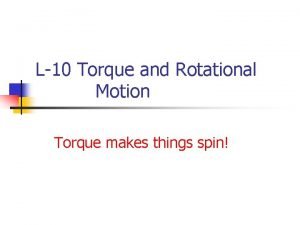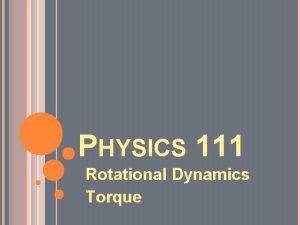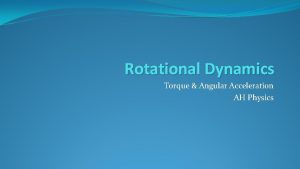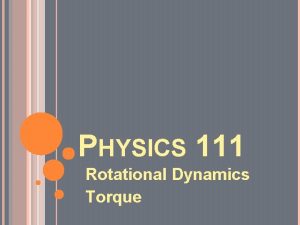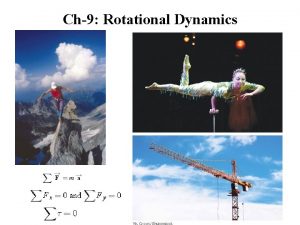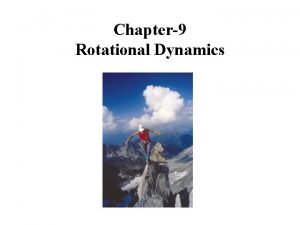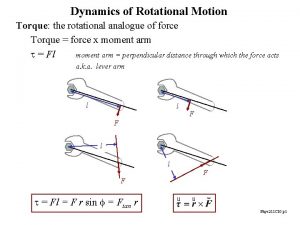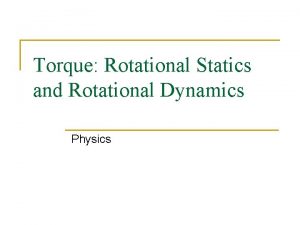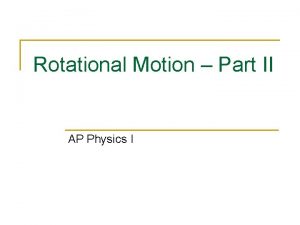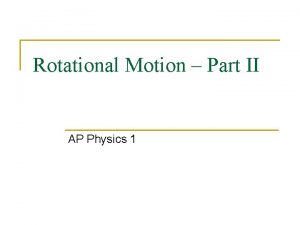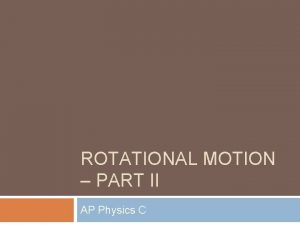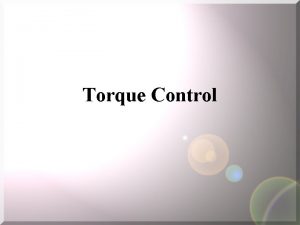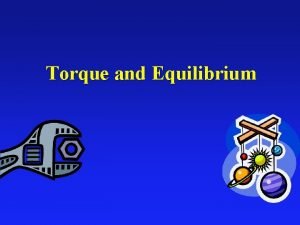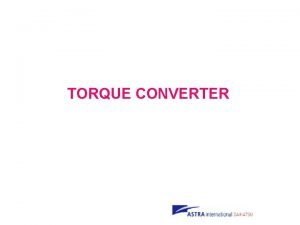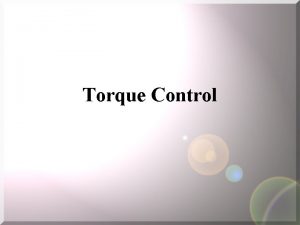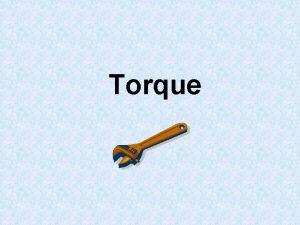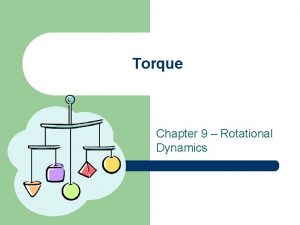Rotational Motion Part II AP Physics C Torque























- Slides: 23

Rotational Motion – Part II AP Physics C

Torque So far we have analyzed translational motion in terms of its angular quantities. But we have really only focused on the kinematics and energy. We have yet to add dynamics (Newton's Laws) to the equation. . Since Newton's Laws governs how forces act on an object we need to look at how force is applied under angular conditions. TORQUE is the ANGULAR counterpart to FORCE. Torque is defined as the Force that is applied TANGENT to the circle rotating around a specific point of rotation.

Torque TWO THINGS NEED TO BE UNDERSTOOD: 1) The displacement from a point of rotation is necessary. Can you unscrew a bolt without a wrench? Maybe but it isn't easy. That extra distance AWAY from the point of rotation gives you the extra leverage you need. THUS we call this distance the LEVER (EFFORT) ARM (r). 2) The Force MUST be perpendicular to the displacement. Therefore, if the force is at an angle, sinq is needed to meet the perpendicular requirement.

Torque is a CROSS PRODUCT If the force is truly perpendicular, then the sine of 90 degrees will equal to 1. When the force is applied, the bolt itself moves in or out of the page. In other words, the FORCE and DISPLACEMENT (lever arm) are in the X/Y plane, but the actual displacement of the BOLT is on the "Z“ axis. We therefore have what is called, CROSS PRODUCT. ØCounterclockwise rotation is considered to be POSITIVE and OUT OF THE PAGE ØClockwise rotation is considered to be NEGATIVE and INTO THE PAGE.

Static Equilibrium According to Newton's first law, if an object is at rest it can be said to be in a state of static equilibrium. In other words, all of the FORCES cancel out to that the net force is equal to zero. Since torque is the angular analog to force we can say that if a system is at rest, all of the TORQUES cancel out. r 1 r 2

Static Equilibrium Example r 1 r 2 Suppose a 4600 kg elephant were placed on a see-saw with a 0. 025 kg mouse. The elephant is placed 10 meters from the point of rotation. How far from the point of rotation would the mouse need to be placed so that the system exists in a state of static equilibrium? 1. 84 x 106 m or 1433 miles (certainly not practical)

What did we forget to include in the last example? r 1 r 2 r 3 THE PLANK ITSELF! If the lever itself has mass, you must include it in the calculations. It’s force( or weight in this case) will act at the rods CENTER OF MASS. If the plank was uniform and its COM was in the middle the equation would have looked like this. COMplank F 3

Not in static equilibrium? If an object is NOT at equilibrium, then it must be accelerating. It is then looked at according to Newton’s Second Law. Under translational conditions a NET FORCE produces an ACCELERATION. Under Angular Conditions a NET TORQUE produces an ANGULAR ACCELERATION. This NEW equation for TORQUE is the Rotational Analog to Newton's second Law.

Example Consider a beam of Length L, mass m, and moment of inertia (COM) of 1/2 m. L 2. It is pinned to a hinge on one end. Determine the beam's angular acceleration. Let’s first look at the beam’s F. B. D. There always vertical and horizontal forces on the pinned end against the hinge holding it to the wall. However, those forces ACT at the point of rotation. FH Fv mg

Example Consider a beam of Length L, mass m, and moment of inertia (COM) of 1/12 m. L 2. It is pinned to a hinge on one end. Determine the beam's angular acceleration. q mgcosq mg In this case, it was the vertical component of the weight that was perpendicular to the lever arm. Also, we had to use the parallel axis theorem to determine the moment of inertia about the END of the beam.

Example Consider a hanging mass wrapped around a MASSIVE pulley. The hanging mass has weight, mg, the mass of the pulley is mp, the radius is R, and the moment of inertia about its center of mass Icm = 1/2 mp. R 2. (assuming the pulley is a uniform disk). Determine the acceleration of the hanging mass. Let’s first look at the F. B. D. s for both the pulley and hanging mass T FN T mh g mp g

Example cont’ FN T a mh g T mp g

Example A trickier problem: Calculate the acceleration of the system: Assume m 1 is more massive than m 2 What you have to understand is that when the PULLEY is massive you cannot assume the tension is the same on both sides. Let’s first look at the F. B. D. s for both the pulley and the hanging masses. T 1 FN T 2 T 1 m 1 g m 2 g mp g

Example cont’ T 2 T 1 m 2 g m 1 g FN T 2 T 1 mp g

Example

Example Consider a ball rolling down a ramp. Calculate the translational acceleration of the ball's center of mass as the ball rolls down. Find the angular acceleration as well. Assume the ball is a solid sphere. Let’s first look at the ball’s F. B. D Fn Ff mg q The key word here is “rolling”. Up to this point we have always dealt with objects sliding down inclined planes. The term “rolling” tells us that FRICTION is causing the object to rotate (by applying a torque to the ball).

Example cont’ Fn Ff q mgcosq mgsinq

Angular Momentum Translational momentum is defined as inertia in motion. It too has an angular counterpart. As you can see we substituted our new angular variables for the translational ones. We can look at this another way using the IMPULSE-MOMENTUM theorem Setting Impulse equal to the change in momentum Or we could look at this from the point of view of torque and its direct relationship with angular momentum.

2 ways to find the angular momentum Rotational relationship In the case for a mass moving in a circle. mass Translational relationship v w R In both cases the angular momentum is the same.

Angular Momentum is also Here is what this says: IF THE NET TORQUE is equal conservedto ZERO the CHANGE ANGULAR MOMENTUM is equal to ZERO and thus the ANGULAR MOMENTUM is CONSERVED. Here is a common example. An ice skater begins a spin with his arms out. His angular velocity at the beginning of the spin is 2. 0 rad/s and his moment of inertia is 6 kgm 2. As the spin proceeds he pulls in his arms decreasing his moment of inertia to 4. 5 kgm 2. What is the angular velocity after pulling in his arms? 2. 67 rad/s

Don’t forget Just like TORQUE, angular momentum is a cross product. That means the direction is always on a separate axis from the 2 variables you are crossing. In other words, if you cross 2 variables in the X/Y plane the cross product’s direction will be on the “Z” axis

Some interesting Calculus relationships

More interesting calculus relationships
 Physics equations quiz
Physics equations quiz Torque rotational motion
Torque rotational motion Ap physics c rotational motion
Ap physics c rotational motion Rigid
Rigid Ap physics 1 rotational motion
Ap physics 1 rotational motion Rotational equilibrium and dynamics
Rotational equilibrium and dynamics Rotational equilibrium
Rotational equilibrium Equation for torque and angular velocity
Equation for torque and angular velocity Torque
Torque Ap physics 1 unit 7 mcq
Ap physics 1 unit 7 mcq Parallel axis theorem ap physics c
Parallel axis theorem ap physics c Rotational motion equations
Rotational motion equations Rotational motion and the law of gravity
Rotational motion and the law of gravity 4 linear motion equations
4 linear motion equations Kinematics equations
Kinematics equations Rotational and linear motion analogies
Rotational and linear motion analogies Circular motion formula
Circular motion formula The blade of a lawn mower is rotating at an angular
The blade of a lawn mower is rotating at an angular Translational vs rotational motion
Translational vs rotational motion Irrotational flow definition
Irrotational flow definition Chapter 8 rotational motion study guide answer key
Chapter 8 rotational motion study guide answer key Static equilibrium rotational motion
Static equilibrium rotational motion Microwave inactive molecules
Microwave inactive molecules Rotational dynamics lab
Rotational dynamics lab
